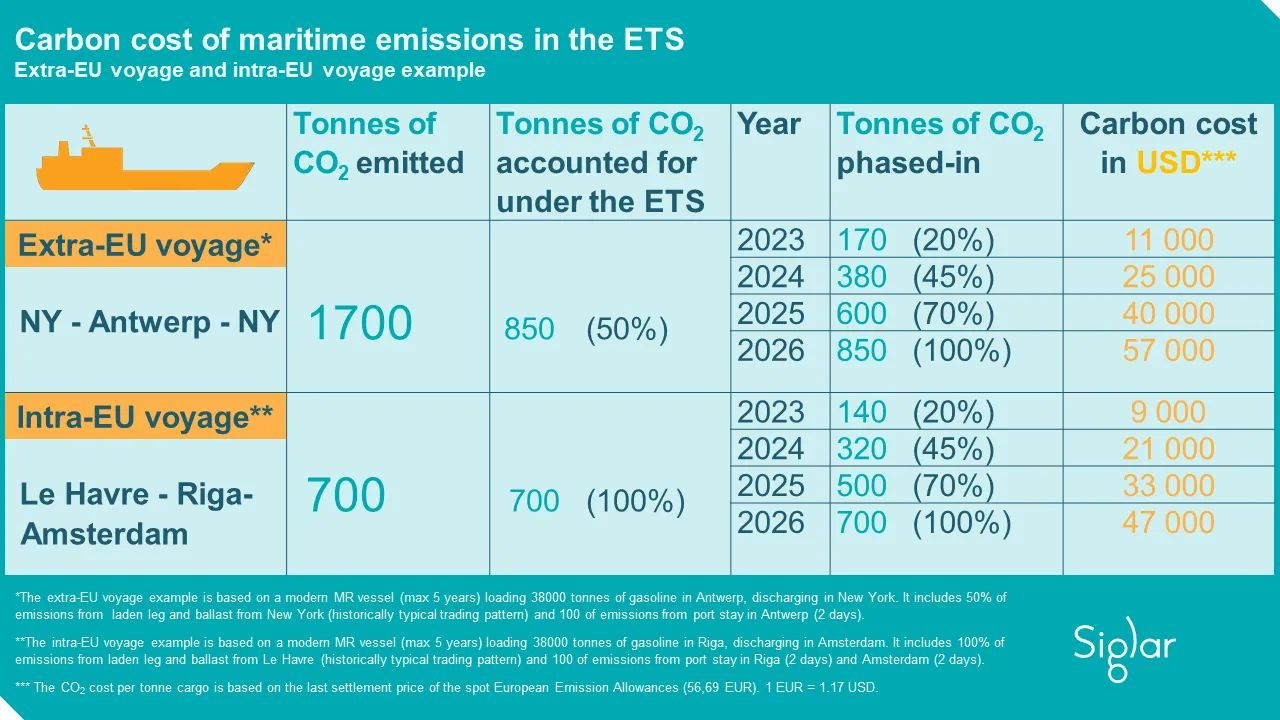Lorem ipsum dolor sit amet, consectetur adipiscing elit. Suspendisse varius enim in eros elementum tristique. Duis cursus, mi quis viverra ornare, eros dolor interdum nulla, ut commodo diam libero vitae erat. Aenean faucibus nibh et justo cursus id rutrum lorem imperdiet. Nunc ut sem vitae risus tristique posuere.
The European Union proposes a basket of measures to decarbonise the maritime industry, which will influence freight rates in different ways. Shipping emissions will become a cost element in freight negotiations and a part of ship owners, brokers and cargo owners' everyday business.

The Fit for 55 package will put a cost on maritime carbon emissions by including shipping in the EU Emissions Trading System (ETS) and it will increase the price of marine bunker fuels by taxing non-sustainable fuels and setting limits to the GHG intensity on ship energy use.
So, how does this impact our everyday business?
The decarbonization measures will result in a first-ever carbon cost in the maritime industry. The increased attention and cost will make emissions a part of day-to-day chartering impacting both shipping and commodity trading.
The inclusion of shipping into the ETS would be the most influential EU measure when it comes to carbon cost.
Buying emissions allowances for a transatlantic (extra-EU) tanker voyage in 2023 would cost approximately 11 000 USD. For a typical intra-EU voyage the carbon cost would be approximately 9 000 USD. In 2026, once the emissions are fully phased-in, the cost would be 57 000 USD for the same gobal EU voyage and 47 USD for the intra-EU voyage.

Example of carbon cost when shipping is fully included in the EU emissions trading system. Extra-EU voyage:

Example of carbon cost when shipping is fully included in the EU emissions trading system. Intra-EU voyage:

Increased understanding of how one’s decisions can drive or reduce maritime emissions is vital to cutting maritime emissions in an efficient manner. The cargo owners particularly, hold powerful tools as their decisions strongly influence the amount of GHG emitted from maritime transport. Understanding the carbon consequences of these decisions, is vital for cargo owners to make the “right” or most carbon efficient decisions, whether it is choosing the right ship for their cargo, deciding the speed of the voyage, or even planning the destination of the cargo.
“We make sure our customers constantly have access to the emissions insight needed to make the most carbon and cost-efficient decisions.” Kyvik adds.
The latest EU proposals have contributed to increasing both the price of and the awareness on maritime emissions making it more important than ever for cargo owners, brokers and traders to understand the carbon consequence of their shipping decisions.
The EU parliament's proposal to review the monitoring, reporting and verification (MRV) Regulation.
If you want more insight into your shipping emissions profile and your future emissions expose, please drop us a line explaining your needs.

The Fit for 55 package will put a cost on maritime carbon emissions by including shipping in the EU Emissions Trading System (ETS) and it will increase the price of marine bunker fuels by taxing non-sustainable fuels and setting limits to the GHG intensity on ship energy use.
So, how does this impact our everyday business?
The decarbonization measures will result in a first-ever carbon cost in the maritime industry. The increased attention and cost will make emissions a part of day-to-day chartering impacting both shipping and commodity trading.
The inclusion of shipping into the ETS would be the most influential EU measure when it comes to carbon cost.
Buying emissions allowances for a transatlantic (extra-EU) tanker voyage in 2023 would cost approximately 11 000 USD. For a typical intra-EU voyage the carbon cost would be approximately 9 000 USD. In 2026, once the emissions are fully phased-in, the cost would be 57 000 USD for the same gobal EU voyage and 47 USD for the intra-EU voyage.
